Python进阶5---StringIO和BytesIO、路径操作、OS模块、shutil模块
StringIO

StringIO操作
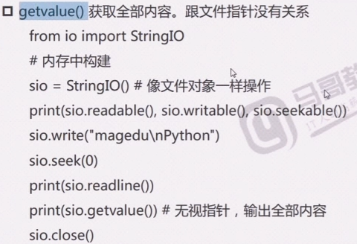

BytesIO

BytesIO操作

file-like对象

路径操作
路径操作模块
3.4版本之前:os.path模块
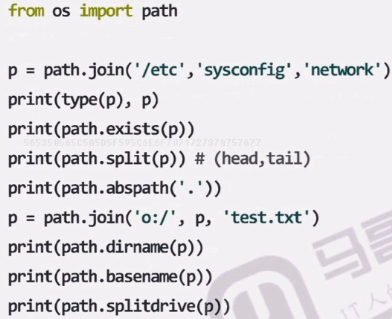
3.4版本开始
建议使用pathlib模块,提供Path对象来操作。包括目录和文件
pathlib模块
from pathlib import Path
目录操作
初始化

路径拼接和分解
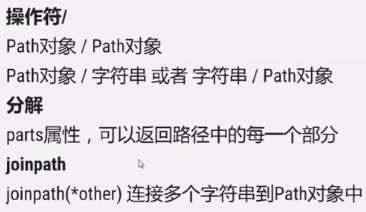
#在windows下的Pycharm中运行 p = Path() print(type(p)) #<class 'pathlib.WindowsPath'> p = p / 'a' print(p) #a p1 = 'b' / p print(p1) #b\a p2 = Path('c') p3 = p2 / p1 print(p3) #c\b\a print(p3.parts) #('c', 'b', 'a') print(p3.joinpath('etc','init.d',Path('httpd'))) #c\b\a\etc\init.d\httpd

p = Path('/etc') print(str(p),bytes(p))

p = Path('/a/b/c/d') print(p.parent.parent) for x in p.parents: print(x)

#四个属性,两个方法 p = Path('E:\learnshare\ArticleSpider\e.xex.txt') print(p.name) #e.xex.txt print(p.stem) #e.xex print(p.suffix) #.txt print(p.suffixes) #['.xex','.txt'] print(p.with_name('c.y'))#E:\learnshare\ArticleSpider\c.y print(p.with_suffix('.xxyy'))#E:\learnshare\ArticleSpider\e.xex.xxyy
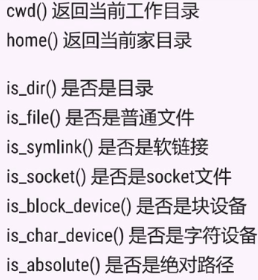
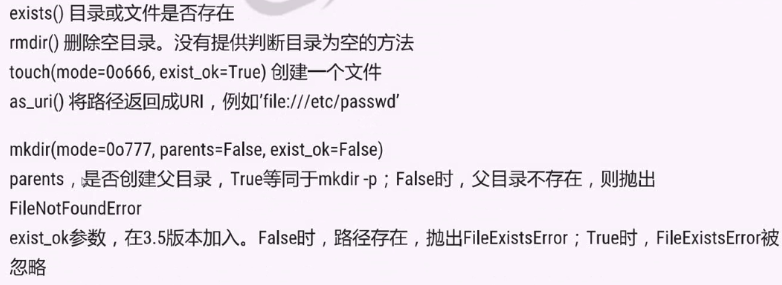

调用iterdir()方法后返回一个生成器对象


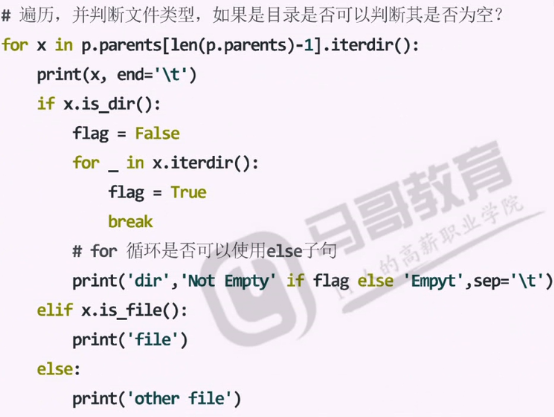
通配符
glob(pattern)通配给定的模式
rglob(pattern)通配给定的模式,递归目录
from pathlib import Path print(1,list(Path().glob('test*')))#返回当前目录对象下的test开头的文件 print(2,list(Path().glob('*/test*')))#返回当前目录的下一级目录以test开头的文件 print(3,list(Path().glob('**/test*')))#递归当前目录以及其下所有目录,返回以test开头的文件 print(4,list(Path().rglob('test*')))#同上一样
匹配
match(pattern)
模式匹配,成功返回True

文件操作
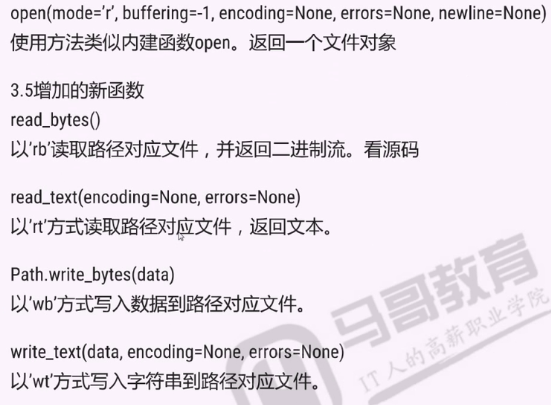


OS模块
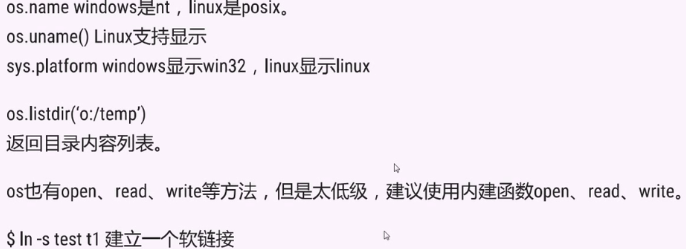

fd表示文件描述符


shutil模块
到目前为止
文件拷贝:使用打开2个文件对象,源文件读取内容,写入目标文件中来完成拷贝过程。但是这样会丢失stat数据信息(权限等),因为根本就没有复制过去。
目录怎么办呢?
Python提供了一个方便的库shutil(高级文件操作)
Copy复制

import shutil with open('test1.txt','r+') as f1: f1.write('abcd\n1234') f1.flush() with open('test2.txt','w+')as f2: shutil.copyfileobj(f1,f2) #注意:由于指针的缘故,可参见源码如下。上述代码中abcd\n1234内容确实会写入到test1.txt,但是并没有复制到test2.txt中。
#copyfileobj源码 def copyfileobj(fsrc, fdst, length=16*1024): """copy data from file-like object fsrc to file-like object fdst""" while 1: buf = fsrc.read(length) if not buf: break fdst.write(buf)


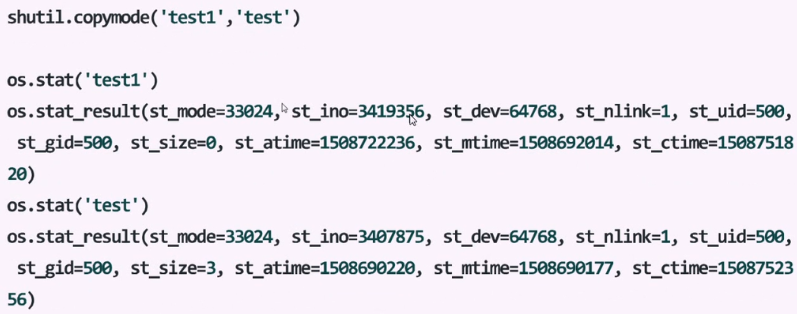




#copytree源码,这里主要了解一下ignore函数的使用技巧,过滤掉不需要拷贝的! def copytree(src, dst, symlinks=False, ignore=None, copy_function=copy2, names = os.listdir(src) if ignore is not None: ignored_names = ignore(src, names) else: ignored_names = set() os.makedirs(dst) errors = [] for name in names: if name in ignored_names: continue srcname = os.path.join(src, name) dstname = os.path.join(dst, name) ...return dst
def fn(src,file_names): filter(lambda x:x.startwith('t'),file_names) #上面的语句等同于下面的语句 fn = lambda src,names:filter(lambda x:x.startwith('t').file_names) #filter(function, iterable) #注意: Pyhton2.7 返回列表,Python3.x 返回迭代器对象
#假设D:/temp下有a,b目录 def ignore(src,names): ig = filter(lambda x:x.startwith('a'),names) #忽略a return set(ig) shutil.copytree('o:/temp','o:/tt/o',ignore=ignore)
rm删除

shutil.rmtree('D:/tmp') #类似rm -rf
move移动

#在同一盘符下,其实质上就是rename,跨盘符的话才是真正的移动 os.rename('D:/temp/x.txt','D:/t.txt') os.rename('test3','/tmp/py/test')

shutil对压缩包的处理是调用ZipFile和ZipFile两个模块来处理的 参考:https://www.cnblogs.com/zjltt/p/6957663.html
csv文件
csv文件简介(文本格式,半结构化数据)
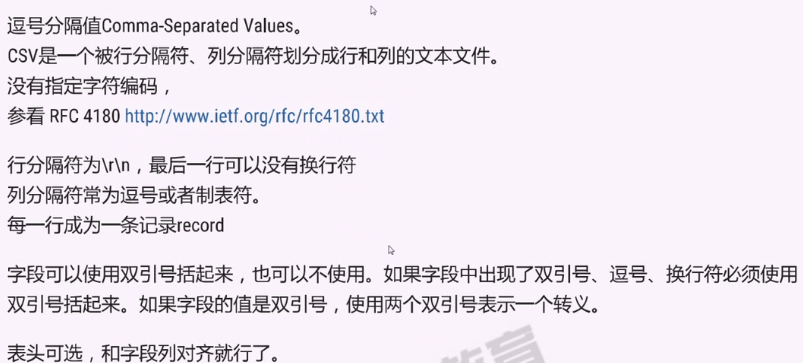
手动生成CSV文件
from pathlib import Path p = Path('F:\\百度网盘下载资料\\Python全栈开发\\python进阶1\\19Python的文件IO(三)(6)\\test.csv') parent = p.parent if not parent.exists(): parent.mkdir(parents=True) csv_body = '''\ id,name,age,comment 1,zs,18,"I'm 18" 2,ls,20,"This is a testing" 3,ww,232,"中 国" ''' p.write_text(csv_body)
csv模块
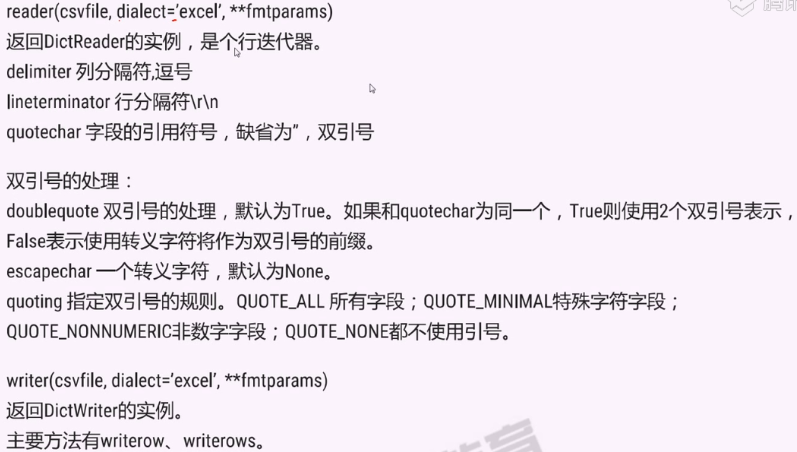
from pathlib import Path import csv p = Path('F:\\test.csv') with open(str(p)) as f: reader = csv.reader(f) print(next(reader)) row = [4,'cty',22,'tom'] rows = [ (1,'2',3,'55'), (11,'123',22,"\"123123") ] with open(str(p),'a+') as f: writer = csv.writer(f) writer.writerow(row) writer.writerows(rows)
ini文件
作为配置文件,ini文件格式很流行
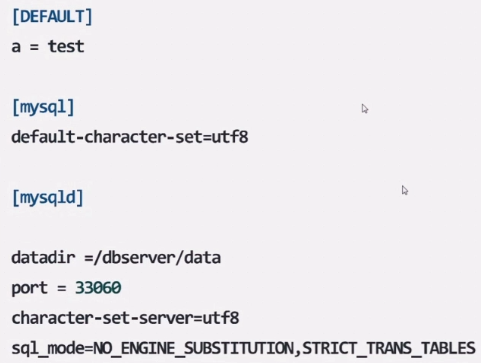
中括号里面的部分称为section。
每一个section内,都是key=value形成的键值对,key称为option选项。
configparser




from configparser import ConfigParser cfg = ConfigParser() cfg.read('mysql.ini') print(cfg.sections()) print(cfg.has_section('deploy')) print(cfg.items('deploy')) for k,v in cfg.items('deploy'): print(k,type(v)) tmp = cfg.get('deploy','a') print(tmp,type(tmp)) print(cfg.get('deploy','a',fallback='python')) print(cfg.getint('mysql','aa')) if cfg.has_section('mysql'): cfg.remove_section('mysql') cfg.add_section('cy') cfg.set('cy','ly','5') cfg.set('cy','ggz','2') # 上面的删除和新增功能需要重新写入文件才会生效 with open('mysql.ini','w') as f: cfg.write(f) print(cfg.getint('cy','ggz')) print(cfg.remove_option('cy','ly')) with open('mysql.ini','w') as f: cfg.write(f)
注意:配置文件一般加载后常驻于内存中,且读取操作远远多于写入操作。
做一枚奔跑的老少年!




 浙公网安备 33010602011771号
浙公网安备 33010602011771号